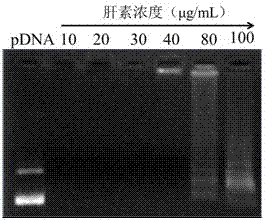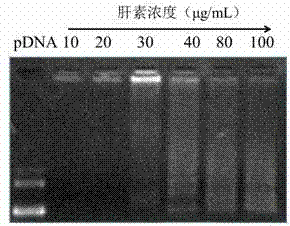Preparation method of light-responsive pegized gene delivery system based on host-guest assembly
A technology of gene delivery and photoresponse, applied in other methods of inserting foreign genetic materials, gene therapy, pharmaceutical formulations, etc., can solve the problems of complex preparation and affecting the ability of gene carriers to associate DNA molecules, etc., to achieve simple preparation and improve gene expression. Simple effects of transfection efficiency, responsive regulation
- Summary
- Abstract
- Description
- Claims
- Application Information
AI Technical Summary
Problems solved by technology
Method used
Image
Examples
Embodiment 1
[0019] Prepare a N-2-hydroxyethylpiperazine-N-2-ethanesulfonic acid (Hepes) buffer solution with a NaCl concentration of 20 mM, a pH of 7.4, and a concentration of 20 mM. Using this buffer solution, a solution of polyethyleneimine grafted cyclodextrin (PEI-CD, PEI molecular weight 25,000) at a concentration of 1 mg / mL and azobenzene-modified polyethylene glycol (Azo -PEG, PEG molecular weight 5000) solution. The green fluorescent protein reporter gene pEGFP (4733bp) was selected as the target gene, and a pEGFP solution with a concentration of 500 μg / mL was prepared. Take 162 μl of the above PEI-CD solution and 88 μl of the above Azo-PEG solution, the molar ratio of CD and Azo-PEG in PEI-CD is 1:1, sonicate for 15 min and then let it stand for 1 h. Then it was mixed with 250 μl DNA solution in an equal volume and left to stand to prepare a light-responsive PEGylated gene delivery system based on host-guest assembly.
Embodiment 2
[0021] Use N-2-hydroxyethylpiperazine-N-2-ethanesulfonic acid (Hepes) buffer solution with a NaCl concentration of 20 mM, pH=7.4, and a concentration of 20 mM, and prepare polyethyleneimine with a concentration of 0.1 mg / mL Grafted cyclodextrin (PEI-CD, PEI molecular weight 25000) solution and azobenzene-modified polyethylene glycol (Azo-PEG, PEG molecular weight 5000) solution at a concentration of 1.5 mg / mL. Prepare a pEGFP solution with a concentration of 50 μg / mL. Take 162 μl of the above PEI-CD solution and 88 μl of the above Azo-PEG solution, the molar ratio of CD and Azo-PEG in PEI-CD is 1:4, sonicate for 15 min and then let it stand for 1 h. Then it was mixed with 250 μl DNA solution in an equal volume and left to stand to prepare a light-responsive PEGylated gene delivery system based on host-guest assembly.
Embodiment 3
[0023] Use N-2-hydroxyethylpiperazine-N-2-ethanesulfonic acid (Hepes) buffer solution with a concentration of 20 mM NaCl, pH=7.4, and a concentration of 20 mM, and prepare polyethylene oxide with a concentration of 1 mg / mL. Amine-grafted cyclodextrin (PEI-CD, PEI molecular weight 25000) solution and azobenzene-modified polyethylene glycol (Azo-PEG, PEG molecular weight 5000) solution at a concentration of 0.4 mg / mL. Prepare a pEGFP solution with a concentration of 50 μg / mL. Take 22 μl of the above PEI-CD solution and 228 μl of the above Azo-PEG solution, the molar ratio of CD and Azo-PEG in PEI-CD is 1:2, sonicate for 15 min and then let it stand for 1 h. Then it was mixed with 250 μl DNA solution in an equal volume and left to stand to prepare a light-responsive PEGylated gene delivery system based on host-guest assembly.
PUM
 Login to View More
Login to View More Abstract
Description
Claims
Application Information
 Login to View More
Login to View More - R&D
- Intellectual Property
- Life Sciences
- Materials
- Tech Scout
- Unparalleled Data Quality
- Higher Quality Content
- 60% Fewer Hallucinations
Browse by: Latest US Patents, China's latest patents, Technical Efficacy Thesaurus, Application Domain, Technology Topic, Popular Technical Reports.
© 2025 PatSnap. All rights reserved.Legal|Privacy policy|Modern Slavery Act Transparency Statement|Sitemap|About US| Contact US: help@patsnap.com



